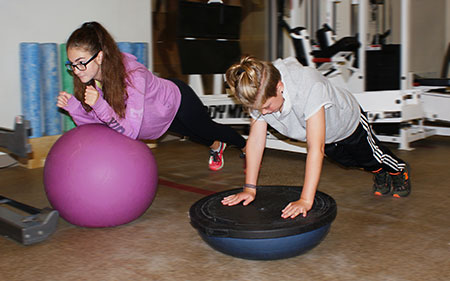Strength and Conditioning for the Young Athlete
An overview for parents and physical therapists
Strength training, also known as resistance training, is a component of sports and physical fitness for young athletes of all ages. Strength training may positively influence athletic performance, prevent and rehabilitate injuries, and improve long-term health. It has been shown to be safe and effective when performed with qualified adult supervision and appropriate exercise selection.

- Is strength training safe for young athletes?
- Why participate in a strength and conditioning program?
- How to implement a strength and conditioning program
What is strength and conditioning?
Strength and conditioning is the application of resistance, plyometric, agility and speed training. Resistance training may involve resistance bands, free weights, weight machines, medicine balls and body weight exercises. Young athletes may choose to participate in a strength and conditioning program to enhance athletic performance, appearance, long-term health and prevent and/or rehabilitate injuries. A strength and conditioning program should be properly supervised, safely progressed, and developed and adjusted based on the young athlete’s’ goals and participation in other physical activities.
Is strength training safe for young athletes?
Yes, when done correctly. Most injuries occur during misuse of gym equipment, using excessive weight, or lifting weights with improper form. A well-designed, well-supervised strength training program has no greater inherent risk of injury than that of any other youth sport. Below are some general safety guidelines:
- As with any sport, a medical evaluation by a pediatrician or family physician is strongly recommended before starting a formal strength-training program. Kids with known heart disorders or high blood pressure must obtain clearance from a physician first.
- Strict supervision by a qualified adult individual, specifically in pediatric strength training (e.g. physical therapist, certified strength and conditioning specialist, or a certified athletic trainer) is mandatory.
- Instructor to student ratio of 1:1, 1:2, or 1:3 is recommended.
- Children and adolescents should begin without resistance and learn proper form and technique. This is required to reduce the risk for injury. When the technique is mastered, additional weight or resistance may be added.
- Young children should not use weight machines that are designed for adults.
- Power lifting, bodybuilding, and maximal lifts are not recommended until physical and skeletal maturity.
Why participate in a strength and conditioning program?
There are many benefits for young athletes to start resistance training. Not only the impact on current and future sports performance, but on self-esteem and socialization. When implemented in a safe, and smart fashion kids can blossom into fit, smart, strong young adults. Below are some of the beneficial outcomes:
- Increase muscle strength, power, and endurance
- Reduce risk of sport-related injuries
- Enhance motor skill performance
- Increase bone mineral density
- Improve body composition
- Improve insulin sensitivity
- Improve blood lipid profile
- Enhance sports performance
How to implement a strength and conditioning program
When participating in a strength and conditioning program it is very important to do so safely in order to minimize risk of injury. When developing a program, one should consider a young athletes current fitness and developmental level. A young athlete can typically safely initiate a program as early at 8 years old, around the age a young athlete begins organized sports. If the athlete is in pain or suffering from an injury prior to or during a strength and conditioning program it is important to address this with a medical professional before continuing.
Below are guidelines based off of the recommendations from the National Strength and Conditioning Association. Following these guidelines can help make initiating and participating in a strength and conditioning program safe, effective and fun.
- Athletes should be cleared by a medical professional prior to initiating any strength and conditioning program.
- Young athletes must be supervised while participating in a strength and conditioning program.
- Sensibly initiate and progress the training program depending on the athletes needs, goals, and abilities.
- Begin each training session with an appropriate active/dynamic warm-up and complete each session with a cool-down that involves less intense calisthenics and static stretching.
- Increase resistance gradually (5–10%) as strength improves as long as proper technique is maintained.
- Begin resistance training 2–3 times per week on nonconsecutive days which will allow for proper recovery between sessions.
- Track progress to ensure and monitor continuous gradual progression, we recommend using an exercise log.
- Keep the program fresh and challenging by systematically varying the training program.
Most importantly, make sure the sessions are fun and varied to encourage active engagement and long-term commitment to a healthy and safe lifestyle.
References:
American Academy of Pediatrics Committee on Sports Medicine and Fitness. Strength training by children and adolescents. Pediatrics. 2008;121(4):835-840.
Dahab KS. And McCambridge TM. Strength training in children and adolescents. Raising the bar for young athletes? Sports Health. 2009;1(3):223-226.
Faigenbaum, A. D., Kraemer, W. J., Blimkie, C. J., Jeffreys, I., Micheli, L. J., Nitka, M., & Rowland, T. W. (2009). Youth resistance training: updated position statement paper from the national strength and conditioning association. The Journal of Strength & Conditioning Research, 23, S60-S79.
Myer GD, Faigenbaum AD, Chu DA, Falkel J, Ford KR, Best TM, Hewett TE. Integrative training for children and adolescents: Techniques and practices for reducing sports-related injuries and enhancing athletic performance. The Physician and Sportsmedicine. 2011;1(39):74-84.
Updated: 11/26/2018
Authors
Tiffany Chag MS, RD, CSCS
Andrea Papson PT, DPT, SCS, CMPT, ATC, CSCS
Rehabilitation Department, Hospital for Special Surgery




